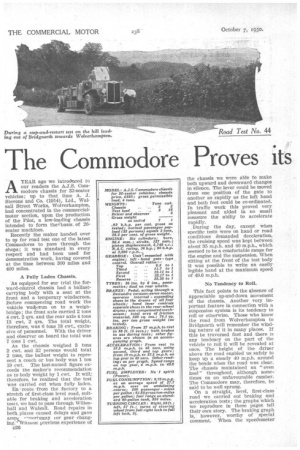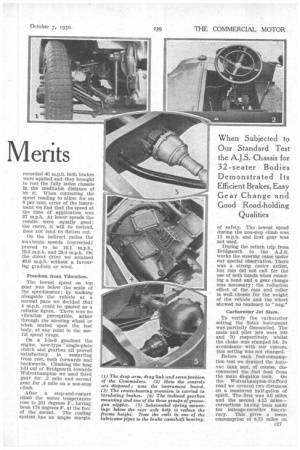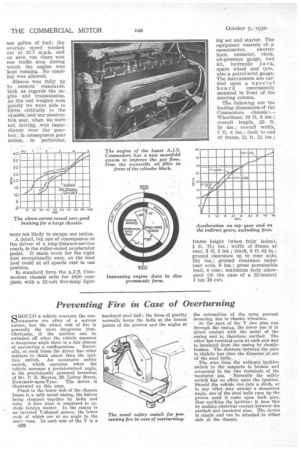The Commodore Proves its
Page 48

Page 49

Page 50

If you've noticed an error in this article please click here to report it so we can fix it.
Merits AYEAR ago we introfteed to our readers the A.J.S. Commodore chassis for 32-seater vehicles; up to that time A. J. Stevens and Co. (1914), Ltd., Walsall Street Works, Wolverhampton, had concentrated in the commercialmotor section, upon the production of the Pilot, a low-loading chassis intended to form thehasis. of 26seater machines.
Recently the maker handed over to us for road test one of the latest Commodores to pass through the shops ; it was standard in every respect and had been used for demonstration work, having covered at the time between 300 miles and 400 miles.
A Fully Laden Chassis.
As equipped for our trial the forward-cOntrol chassis had a ballastcarrying body with a seat at the front and a temporary windscreen. Before commencing road work the vehicle wair.frun on to a weighbridge; the front axle carried 2 tons 4 cwt. 2 qrs. and the rear axle 1 tons 13 cwt. 2 qrs. The total weight, therefore, was 6 tons 18 cwt:, exclusive of personnel. With the driver and observer on board the total was 7 tons 1 cwt.
As the chassis weighed 3 tons 2 cwt. and 32 persons would total 2 tons, the ballast weight to represent a coach or bus body was 1 ton 19 cwt. The last-named figure exceeds the maker's recommendation as to body weight by 1 cwt. It
therefore, be realized that the test was carried out when fully laden.
En route from the factory to a stretch of first-class level road, suitable for braking and acceleration tests, we had to pass through Wittenhall and Walsall. Road repairs in both, places caused delays and gave
amp t. Jur gear changing.--Wititour previous experience of c26
the chassis we were able to make both upward and downward changes in silence. The lever could be moved from one position of the gate to another as rapidly as the left hand and both feet could be co-ordinated. In traffic work this proved very Pleasant and aided in no small measure the abilty to accelerate rapidly.
During the day, except when specific tests were on hand or road c-onditions demanded deceleration, the cruising speed was kept between about 35 m.p.h. and 40 m.p.h., which seemed to be a comfortable range for the engine and the suspension. When sitting at the front of the test body it was possible to write an easily legible hand at the maximum speed of 49.6 m.p.h.
No Tendency to Roil.
This fact points to the absence of appreciable up-and-down movement of the chassis. Another very itnportant feature in connection with a suspension system is its tendency to roll or otherwise. Those who know the road from Wolverhampton to Bridgnorth will remember the winding nature of it in many places. If this be traversed fast and there is any tendency on the part of the vehicle to roll it will be revealed at once. The height of the drier above the road enabled us safely to keep up a steady 40 m.p.h. around the bends when the road was clear. The chassis maintained an " even keel" throughout, although sometimes on an unfavourable camber. The Commodore may, therefore, be said to be well sprung.
On a straight, level, first-class road we carried out braking and acceleration tests ; the graphs which we reproduce in these pages tell their own story. The braking graph is, however, worthy of special comment. When the speedometer recorded 40 m.p.h. both brakes were applied and they brought to rest the fully laden chassis in the creditable distance of 88 ft. When correcting the speed reading to allow for an 8 per cent, error of the instrument we find that the speed at the time of application was 37 m.p.h. At lower speeds the results were equally good; the curve, it will be noticed, does not tend to flatten out.
On the indirect ratios the maximum speeds (corrected) proved to be 10.1 m.p.h., 10.3 m.p.h. and 29.4 m.p.h. On the direct drive we attained 49.6 m.p.h. without a favourlag gradient or wind.
Freedom from Vibration.
The lowest speed on top gear was below the scale of the speedometer ; by walking alongside the vehicle at a normal pace we decided that 4 m.p.h. could be quoted as a reliable figure. There was no vibration perceptible, either through the steering wheel or when seated upon the test body, at any point in the useful speed range.
On a 1-in-6 gradient the engine, new-type single-plate clutch and gearbox all proved satisfactory in restarting from rest, both forwards and backwards. Climbing the long hill out of Bridgnorth towards Wolverhampton we used third gear for .2 mile and second gear for .4 mile on a non-stop climb.
After a stop-and-restart climb the water temperature rose to 201 degrees F., having been 174 degrees F. at the foot of the ascent. The cooling system has an ample margin of safety. The lowest speed during the non-stop climb was 11 m.p.h. and first gear was not used.
During the return trip from Bridgnorth to the A.J.S. works the steering came under our special observation. There was a strong castor action, but this did not call for the use of both hands when rounding a bend and a gear change was necessary ; the reduction effect of the cam and roller is well chosen for the weight of the vehicle and the wheel showed no tendency to "nag."
Carburetter Jet Sizes.
To verify the carburetter setting the Solex instrument was partially dismantled. The main and pilot jets were 160 and 70 respectively, whilst the choke was stamped 34. In accordance with our custom, this setting was not changed.
Before each fuel-consumption test we drained the Autovac tank and, of course, disconnected the fuel feed from the main 40-gallon tank. On the Wolverhampton-Stafford road we covered two distances on a measured half-gallon of spirit. The first was 4.6 miles and the second 4.15 miles— corrections having been made for mileage-recorder inaccuracy. This gives a mean consumption of 8.75 miles on one gallon of fuel; the average speed worked out at 27.7 m.p.h. and on each run there was one traffic stop during which the engine was kept running. No coasting was allowed.
Silence was fully up to modern standards, both as reg,ards the engine and transmission. As the test weights rode quietly we were able to liSten critically to the chassis, and our observation seat, when we were not driving, , was immediately over the gearbox ; in consequence gear noises, in particular, were not likely to escape our notice.
A detail, but one of consequence to the driver of a long-distance-service coach, is the roller-ended accelerator pedal. It made work for the right foot exceptionally easy, as the boot heel could at all speeds rest in one position.
In standard form the A.J.S. Commodore chassis sells for £850 complete with a 12-volt five-lamp light ing set and starter. The equipment consists of. a speedometer, electric horn, ammeter, clock, oil-pressure gauge, tool kit, hydraulic j a c k, spare wheel and tyre, also a petrol-level gauge, The instruments are carried upon a special board conveniently mounted in front of the steering column.
Tfie following are the leading dimensions of the Commodore chassis :-Wheelbase, 16 ft. 6 ins.; overall length, 25 ft. 3-i ins.; overall width, 7 ft. 4 ins.; dash to end of frame, 21 ft. 2i ins.;
frame height (when fully laden), 1 ft. 11i ins.; width of frame at rear, 3 ft. 5 ins.; track, 6 ft. 01 in.; ground clearance up to rear axle, 10i ins.; ground clearance under rear axle, 8 ins.; gross permissible load, 4 tons ; maximum body allowance (in the case of a 32-seater) 1 ton 18 cwt.












































































































